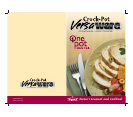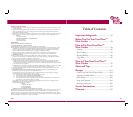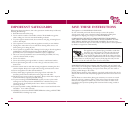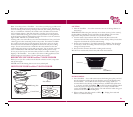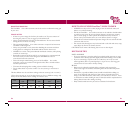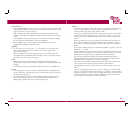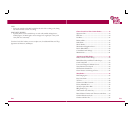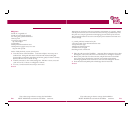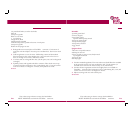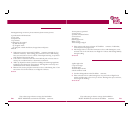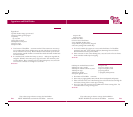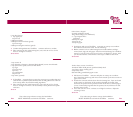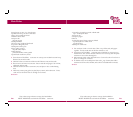
VEGETABLES
• Many vegetables benefi t from slow cook times and low temperatures and are able
to develop their full fl avor. ey tend not to overcook in your slow cooker as they
might in your oven or on your stovetop.
• When cooking recipes with vegetables and meat, place the vegetables in the
stoneware before the meat. Vegetables usually cook slower than meat in the slow
cooker.
• Place vegetables near the sides or bottom of the stoneware to facilitate cooking.
Stir in chopped or sliced vegetables with other ingredients.
• Because eggplant has a very strong fl avor, you should parboil or sauté the
eggplant before adding it to the slow cooker.
LIQUIDS
• It is not necessary to use more than ½ to 1 cup liquid in most instances since
juices in meats and vegetables are retained more in slow cooking than in
conventional cooking.
• When converting conventional cooking recipes to slow cooking recipes, use
about half of the recommended amount of liquids, except in recipes that contain
uncooked rice or pasta (see previous page).
MILK
• Milk, cream, and sour cream break down during extended cooking. When
possible, add during last fi fteen minutes to half hour of cooking, until just heated
through.
• Condensed soups may be substituted for milk and can cook for extended times.
SOUPS
• Some soup recipes call for 2 to 3 quarts of water. Add other soup ingredients to
the slow cooker fi rst; then add water only to cover. If thinner soup is desired, add
more liquid at serving time.
• If milk-based soup recipes have no other liquid for initial cooking, add 1 or 2
cups water. Since milk, cream or sour cream will break down if heated above
boiling point, carefully stir them in at end of cooking cycle.
MEATS
• For meats, trim fats, wipe or rinse well, and pat dry with paper towels. Browning
meat in a separate skillet or broiler allows fat to be drained off before slow
cooking and also adds greater depth of fl avor to dish.
• Larger roasts, chickens, and hams are the perfect size for your slow cooker. Select
boneless roasts or hams ranging from 2 to 4 pounds for a 4-quart slow cooker,
2.5 to 5 pounds for a 5-quart slow cooker, and 3 to 6 pounds for a 6-quart slow
cooker.
• Bone-in cuts like ribs, loin cuts, or turkey pieces fi t easily and cook well in your
slow cooker. Cook turkey legs, thighs, and breasts, up to 4 pounds for 4-quart
slow cookers, 5 pounds for 5-quart slow cookers, and 6 pounds for 6-quart slow
cookers.
• If you select a smaller roast, alter the amount of vegetables or potatoes so that the
stoneware is ½ to
3
/
4
full.
• Always remember, the size of the meat and the recommended cook time are just
estimates. e exact weight of a roast that can be cooked in the slow cooker will
depend upon the specifi c cut, meat confi guration, and bone structure.
• Cut meat into smaller pieces when cooking with precooked beans, fruit, or
lighter vegetables such as mushrooms, diced onion, eggplant, or fi nely minced
vegetables. is will enable food to cook at the same rate.
• Lean meats such as chicken or pork tenderloin will cook faster than meats with
more connective tissue and fat such as beef chuck or pork shoulder.
• Meat should be positioned so that it rests in the stoneware and does not touch
the lid.
• If you are cooking frozen meats (such as roasts or chickens), you must fi rst add
at least 1 cup of warm liquid. e liquid will act as a “cushion” to prevent sudden
temperature changes. For most recipes containing cubed frozen meat, cook meats
an additional 4 hours on LOW or 2 hours on HIGH. For large cuts of frozen
meat, it may take much longer to defrost and tenderize.
E8
E9



